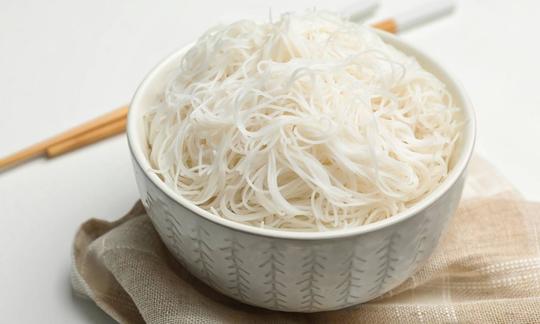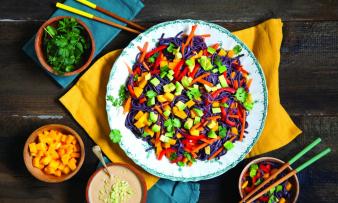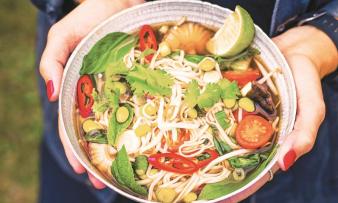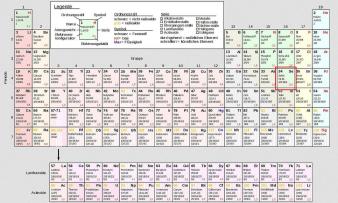Table of contents
Cooked rice noodles is traditionally used for soups or fried together with vegetables and tofu as a wok dish.
Use in the kitchen
Rice noodles are made from rice flour and water. They are usually bought dried in portion balls. There are flat, wide noodles, which are known as rice ribbon noodles, and thin 'spaghettini' (also known as vermicelli). Wholegrain rice noodles are becoming increasingly popular in Europe and America. In Asia, white rice noodles are still preferred. As you can read below, rice noodles contain fewer calories (kcal or kJ per 100 g, i.e. kilojoules) than pasta.
How do you prepare rice noodles? The thin variety only needs to be poured over boiling water and left to simmer for 2 to 3 minutes. You can then add them to soup or use them in a dish. The flat, wide noodles take longer to soften. You can soak them in hot water for 8 to 10 minutes and then use them for a stir-fry (wok dish). Alternatively, you can boil them in water for around 3 minutes. The latter is particularly suitable if you want to use the rice noodles cold for salads or wraps. It is important that you rinse the noodles briefly with cold water after soaking or boiling them in water. If you are not using them straight away, it is advisable to either cover the noodles with plastic wrap or leave them in cold water so that they do not stick together or dry out.
How do you tell rice noodles from glass noodles? Rice noodles are still whitish after cooking. Once glass noodles have been cooked, they are transparent. Glass noodles are made of water and starch extracted from peas, corn or mung beans.
Cooked rice noodles are a great base for fresh salads, for example for a fresh Thai mango salad. After cooking the rice noodles and rinsing them in cold water, sprinkle them with a little oil or lime juice so that they don't stick together as much. They also taste great in an Asian soup, for example in a Vietnamese pho with pak choi. Rice noodles go well with all kinds of steamed vegetables, such as red bell peppers, turnip greens, shiitake mushrooms, as well as tofu or tempeh.
Vegan rice noodle salad with lime and peanut dressing
Ingredients (for 2 people): 250 rice noodles, 150 g red cabbage, 100 g red bell peppers, 250 g cucumber, 100 g carrots, 1 clove of garlic, 10 g ginger, 1 tbsp peanut butter, 2 tbsp soy sauce (tamari), juice of one lime, 2 tbsp rice vinegar, 1 spring onion, 1 red chili pepper, 1/2 bunch of coriander leaves, 2 tbsp peanuts.
Preparation: Cook the rice noodles in boiling water for 2-3 minutes. Then rinse with cold water, drain and allow to cool. Wash the red cabbage and carrots and finely slice. Wash the red bell peppers and cucumber and cut into thin slices. For the dressing, press the garlic clove and either finely chop the ginger or grate it finely. Mix the garlic and ginger with the peanut butter, soy sauce, lime juice and rice vinegar. Mix the chopped vegetables and the cooled rice noodles with the dressing. Wash the spring onions and chili peppers and cut into thin rings. Finely chop the peanuts. Wash the coriander leaves and chop roughly. Mix the spring onions, chili peppers, peanuts and coriander leaves into the salad.
Vegan recipes with cooked rice noodles can be found under the note: " Recipes that have the most of this ingredient ".
| Not only vegans or vegetarians should read this: Vegans often eat unhealthily. Avoidable nutritional errors. |
Purchasing - Storage
Rice noodles can usually only be bought in dried form. They can be found in large supermarket chains such as Coop, Migros, Denner, Volg, Spar, Aldi, Lidl, Billa, Rewe, Edeka or Hofer, and occasionally in controlled organic quality (organic quality). However, some discounters only stock them during special promotions. Rice noodles can also often be bought in organic supermarkets such as Denn's Biomarkt or Alnatura, as well as in Asian shops.
When producing rice noodles, they are heated several times, which is why they are no longer considered raw food (more on this under Industrial Production).
The availability of rice noodles in the supermarkets mentioned varies depending on the size of the store, catchment area, etc. If you are interested, click on our recorded food prices for the DA-CH countries (above under the ingredient image). There you will find current prices from various supermarkets and their price development.
Storage tips:
Dried rice noodles can be stored like pasta made from other grains. They should be stored in the original packaging or in a closed container in a cool, dry and dark place. This way they will last for around a year or until the best-before date. 2
Ingredients - Nutritional values - Calories
Cooked rice noodles (organic) contain 108 kcal per 100 g. With 0.20 g fat and 1.0 g dietary fiber per 100 g, they are low in fat and fiber. They only have 1.8 g/100g protein. The salt content is 48 mg/100g. 1 Calorie in comparison to cooked pasta: Ribbon noodles 142 kcal, durum wheat noodles 156 kcal, soy noodles 155 kcal, spaetzle 164 kcal, tagliatelle 159 kcal. In the raw state, this is practically always several times more calories. One kcal corresponds to 4,184 kJ.
How many calories do rice noodles have? Cooked rice noodles have 24 g of carbohydrates per 100 g. In comparison, cooked pasta (durum wheat semolina) has around 30.6 g/100g of carbohydrates. 1
Like the white long-grain rice from which the noodles are made, rice noodles contain selenium and manganese and some important amino acids. However, the ingredients are drastically reduced during cooking, so that the cooked rice noodles contain very little nutritional value.
The complete ingredients of cooked rice noodles, the coverage of the daily requirement and comparison values with other ingredients can be found in our nutrient tables. In the article Nutrients explained you will get a detailed insight into the topic.
Effects on health
Are rice noodles healthy? Rice noodles are a good gluten-free pasta alternative for people with gluten intolerance (celiac disease). Look for the gluten-free symbol, which only licensed products are allowed to carry, as contamination can occur during processing because the same machines are used for grain processing. Other gluten-free grains are corn, millet, buckwheat, amaranth and quinoa. 6
Dangers - Intolerances - Side effects
Are rice noodles unhealthy? Rice and rice products can contain increased levels of the toxic semi-metal arsenic. The plant absorbs this from the soil and water and stores it in the grains. The arsenic content in rice varies depending on the rice-growing region, as it depends on the arsenic content in the soil and water. Rice from wet rice cultivation usually has higher levels, as flooding of the soil releases the arsenic more easily. 6
Since 2015, there has been an EU regulation that sets maximum levels of arsenic in rice and rice products. 4 High levels can also be found in some rice products such as rice flakes and rice noodles. Young children absorb arsenic even more easily than adults, which is why it is recommended that children under 3 years of age are not fed primarily rice and rice products. 5,6
Ecological footprint - animal welfare
Rice noodles are usually made from the flour of white long-grain rice. 3 Rice is one of the world's most important plants, as it is the staple food for almost half of the world's population. 7 However, the cultivation of rice has a very harmful effect on the environment, as it leads to increased greenhouse gas emissions and uses a lot of water. When rice is cultivated wet, the rice fields are regularly flooded. This leads to an increase in bacteria that decompose the organic material in the soil (plant residues) and thus produce methane. This gas is around 25 times more harmful to the climate than carbon dioxide (CO 2). 9
The Big Climate Database gives the ecological CO 2 footprint of Rice flour with 1.14 kg CO 2 eq/kg and rice noodles with 1.41 kg CO 2 eq/kg 13. We do not know the amount of water needed to produce 1 kg of rice noodles, but the water consumption for producing 1 kg of rice is around 2500 l, and for rice flour it is even higher at 2628 l. 14
If artificial irrigation systems are used for wet rice cultivation, the ecological footprint and the amount of water required increases even further. 12 In addition, flooding the soil releases the toxic semi-metal arsenic, which the plants absorb and store in the rice grains. 6 Compared to wet rice cultivation, dry rice cultivation is less harmful to the environment and the climate due to lower water consumption and lower methane production. 8
In Asian countries (such as Vietnam), rice noodles are produced and consumed on a large scale. The wastewater generated during production must be disposed of properly, as it contains large amounts of complex organic compounds. However, wastewater treatment plants are sometimes too expensive, which is why research is being carried out into alternatives. 15
Worldwide occurrence - cultivation
Rice noodles originate from China and have been documented since the Qin Dynasty (259-210 BC). They are particularly popular in southern China and Southeast Asia and are a component of many traditional dishes. 3
Industrial production
Dried rice noodles are industrially prepared products that mostly consist of 80-90% rice flour and water. They sometimes also contain tapioca flour or corn starch to make them appear more transparent and improve the consistency.
For the industrial production of rice noodles, the raw rice is soaked in water for several hours after it has been thoroughly cleaned. After the rice has absorbed enough water, it is ground until it has a porridge-like consistency. The rice porridge is then heated and formed into thin noodles ( 'spaghettini') either by pressing (extruding) it or by cutting flat rice sheets ( rice ribbon noodles). The noodles are heated again, then cooled and left to dry before being packaged. 3
Further information
Rice noodles are made from rice flour, mainly from long grain rice ( Oryza sativa ssp. indica) 3, and water. There are three main types of rice noodles: the thin 'spaghettini' pressed through a mold with holes, the noodles cut from a rice sheet ( rice ribbon noodles) and rice paper for wraps. Each type can be bought fresh or dried. 3
The Asian rice noodles should not be confused with the Greek Kritharáki or the Italian Orzo, Manestra or Risoni. These are small noodles in the shape of grains or rice, which is why they are also called 'rice noodles'. However, they are not made from rice, but from durum wheat semolina and barley.
Alternative names
Rice noodles come in the form of thin 'spaghettini ' (also called vermicelli) or as wide, flat rice ribbon noodles. In English, rice noodles are called rice noodles or rice vermicelli.
Bibliography - 13 Sources
| 1. | USDA United States Department of Agriculture. Rice noodles, dry. |
| 2. | Bundeszentrum für Ernährung. Lebensmittellagerung im Haushalt (PDF). |
| 3. | Cereals and Grains Association. Traditional Chinese Rice Noodles: History, Classification, and Processing Methods (PDF). |
| 4. | Verordnung (EU) 2015/1006 der Europäischen Kommission zur Änderung der Verordnung 1881/2006 hinsichtlich der Höchstgehalte für anorganisches Arsen in Lebensmitteln. |
| 5. | Bundesinstitut für Risikobewertung. EU-Höchstgehalte für anorganisches Arsen in Reis und Reisprodukten durch Verzehrsempfehlungen zum Schutz von Säuglingen, Kleinkindern und Kindern ergänzen. Aktualisierte Stellungnahme Nr. 017/2015 des BfR vom 06. Februar 2014. |
| 6. | Bundesinstitut für Risikobewertung. Fragen und Antworten zu Arsengehalten in Reis und Reisprodukten. Aktualisierte FAQ des BfR vom 22. Dezember 2020. |
| 7. | National Geographic. Staple Food Crops of the World. |
| 8. | Pini U. Das Bio-Food Handbuch. Ullmann Verlag: Potsdam; 2014: 609-611. |
| 9. | SWR Fernsehen. 5 Tausch-Tipps für klimabewusste Lebensmittel. |
| 12. | WWF. Living Waters, Conserving the source of life, Thirsty Crops (PDF). |
| 13. | CONCITO. The Big Climate Database, version 1. 2021. |
| 14. | Mekonnen MM, Hoekstra AY. The green, blue and grey water footprint of crops and derived crop products. Hydrol. Earth Syst. Sci. 2011; 15: 1577-1600. |
| 15. | Nguyen XC, Chang SW, Tran TCP, et al. Comparative study about the performance of three types of modified natural treatment systems for rice noodle wastewater. Bioresource Technology. 2019; 163-170. |










Comments